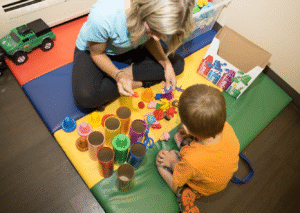When a neurological disorder affects how someone speaks, understands, swallows, or communicates, it’s more than just frustrating. It can feel isolating, scary, and overwhelming for individuals and their families. But there is hope and a path forward.
Speech therapy is more than improving pronunciation or learning new words. Speech therapy harnesses the incredible adaptability of the human brain to help people rebuild vital skills. Whether it’s a toddler with a genetic condition or an adult recovering from a stroke, the brain has the capacity to heal and rewire. Speech-language pathologists (SLPs) are trained to guide that process with expertise and compassion.
What Is Neuroplasticity?
Neuroplasticity is the brain’s built-in ability to reorganize and form new neural pathways after an injury, illness, or developmental disruption. It’s why a child with cerebral palsy might eventually speak in full sentences, or why an adult relearning language after a traumatic brain injury can regain the ability to read or write.
The brain is not fixed; it’s constantly adapting. Speech therapy is designed to make the most of that adaptability through targeted, repetitive practice, real-life communication, and supportive interventions that meet the individual exactly where they are.
Neurological Conditions That Benefit from Speech Therapy
Speech therapy is commonly used for both pediatric and adult populations affected by conditions like:
- Stroke (CVA)
- Traumatic brain injury (TBI)
- Cerebral palsy
- Autism spectrum disorder
- Developmental delays
- Down syndrome
- Parkinson’s disease
- Multiple sclerosis
- ALS
- Genetic or chromosomal syndromes
Every diagnosis presents unique challenges, but speech-language therapy offers a personalized path forward for each individual, no cookie-cutter solutions here.
How Speech Therapy Helps Rewire the Brain
Here’s how speech-language pathologists help re-engage the brain and body through proven, personalized strategies:
1. Repetitive, Purposeful Practice
Speech therapy is built on structured repetition. SLPs help individuals practice sounds, gestures, words, or sequences again and again to create stronger neural pathways. This type of focused repetition teaches the brain: “This matters. Let’s reinforce it.”
2. Multisensory Engagement
Speech therapists often use visual cues, tactile tools, or auditory feedback to help clients experience language through multiple senses. For example, tapping a rhythm while saying a phrase can help someone with apraxia of speech sequence sounds more effectively. This multisensory approach lights up more areas of the brain and promotes deeper learning.
3. Real-Life Communication
Speech therapy is about building communication that matters in daily life. Whether it’s ordering food, telling a story, or expressing needs, these real-world interactions make therapy more meaningful and memorable. The more functional the practice, the better the carryover.
4. Cognitive-Linguistic Rehabilitation
When someone experiences a stroke or brain injury, it’s not just language that’s affected. Memory, attention, sequencing, and organization can all take a hit. SLPs provide cognitive-linguistic therapy to rebuild these foundational thinking skills.
5. Dysphagia Therapy (Swallowing Support)
Neurological disorders often affect muscles used for swallowing. Through targeted exercises, postural adjustments, and sensory stimulation, speech therapy helps individuals swallow more safely and effectively, reducing the risk of choking or aspiration pneumonia.
Why Early Intervention Matters for Children
For children with neurological diagnoses, speech therapy can be life-changing. Because young brains are highly plastic, early intervention leads to better long-term outcomes.
Speech therapy can help children:
- Develop vocabulary and sentence structure
- Improve social skills like turn-taking and eye contact
- Increase oral motor coordination for chewing, swallowing, or speaking
- Reduce frustration caused by limited communication
Early access to services ensures that your child doesn’t miss critical developmental windows. And with consistent support, kids often make incredible gains and catch up to peers over time.
Reclaiming Communication as an Adult
Adults who experience neurological changes often face a different journey. Losing the ability to communicate after a stroke or brain injury can be devastating. But speech therapy offers a way forward with patience, persistence, and skilled intervention.
SLPs help adults:
- Retrain the brain to speak, write, or understand language
- Use tools like picture boards, apps, or writing to supplement speech
- Improve clarity, fluency, and confidence in conversations
- Reduce anxiety or depression related to communication barriers
No matter how long it’s been since a stroke or injury, progress is possible. People are often surprised by how much they can regain with the right support.
Our Approach
At Crawl Walk Jump Run, we believe therapy should be as individualized as the people we serve. Our speech-language pathologists are experienced in working with neurological conditions and take a whole-person approach to care.
We offer:
- Comprehensive evaluations
- Personalized treatment plans
- Evidence-based techniques like PROMPT, AAC, and cognitive-linguistic rehab
- Close collaboration with our physical and occupational therapy teams
- Emotional support for caregivers and families
Communication is Connection
When someone regains the ability to say “I love you,” share a thought, or ask for what they need, it’s not just a win in therapy—it’s a win in life. Speech therapy helps individuals with neurological disorders reconnect with the world around them, and with the people they love.Whether your loved one is learning to communicate for the first time or relearning how to express themselves, therapy can help them write the next chapter with confidence. Contact us to schedule an evaluation and take the first step toward progress.




